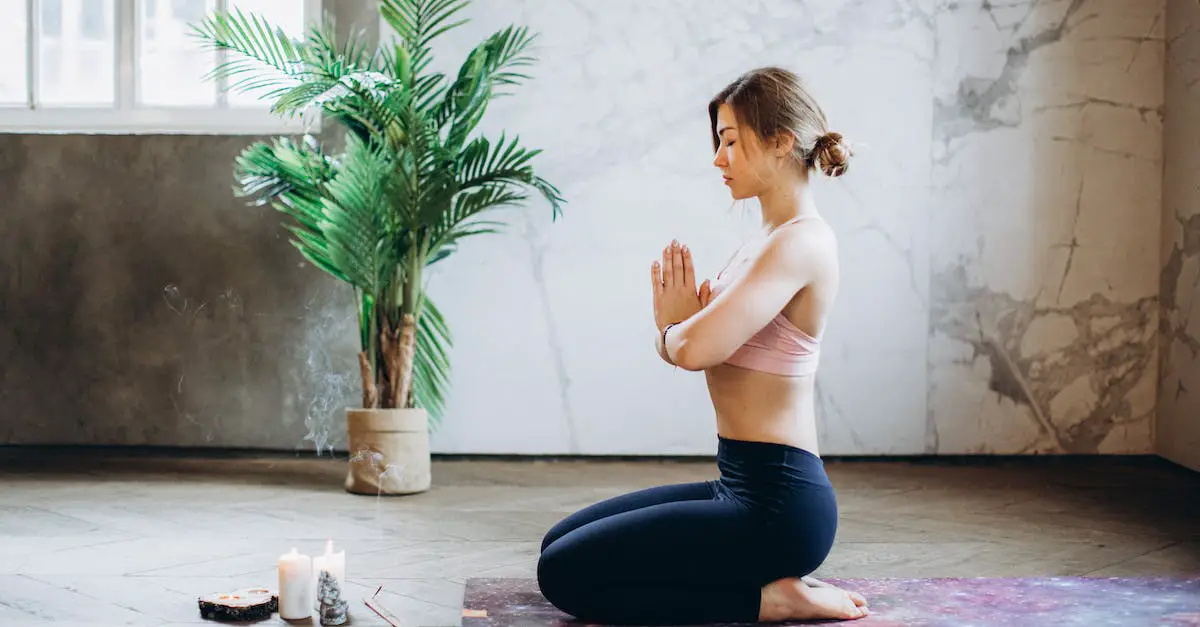Wondering how to become more self-aware?
How to discover a deeper understanding of yourself and the world around you?
You’re not the only one! Many people throughout history have searched for the answer, from ancient monks to modern yogis. But what do they have in common? They’ve all turned to meditation! Whether you’ve heard of meditation or not, it’s a compelling way to become more self-aware and understanding. This article will discuss why meditation is so powerful and how to develop a meditative state to increase self-awareness and understanding.
Reflecting on past experiences, our values, and our purpose in the world can be overwhelming and even harrowing, yet achieving a better understanding of ourselves is necessary. By practicing meditation, we clear our minds and become more open to the thoughts, feelings, and experiences lying beneath the surface. This helps us grapple with and resolve the nuances of our anxieties and experiences.
-

Celestial Soul Eco-Friendly Tote Bag
$18.50 Select options This product has multiple variants. The options may be chosen on the product page -

Celestial Soul Women’s T-Shirt
Price range: $20.00 through $21.50 Select options This product has multiple variants. The options may be chosen on the product page
So, if you’re looking for a way to become more self-aware, why not try meditation? And if you’re surprised by this suggestion, don’t worry! We’ll discuss why meditation is so powerful and how to develop a meditative state to increase self-awareness and understanding. It’s time to discover the power of meditation and the secrets it holds!
Defining a Meditative State

So, you’ve heard of this thing called “meditation” before, and you’re curious to learn more about it. Well, you’ve come to the right place! This article will dig into what it is and how you can define a meditative state.
Here’s the skinny. A meditative state is essentially a form of deep relaxation. It’s that zen-like calm you get when you sit and let the day’s worries float away. For this article, we’ll define a meditative state as a space of quiet contemplation—the kind of mindful awareness and heightened sense of self that allows you to consider things objectively without distraction.
So, what exactly does it take to enter such a state? Is it just blowing away the cobwebs and letting go of the stresses of the day? Or is there something more to it? Well, it depends on who you ask.
One thing is certain: the practice is personal. Though we can look at a meditative state’s physical and mental aspects, those only begin to scratch the surface. Going deeper involves focused attention, where mindfulness is the goal. The aim is to be aware of each moment, free of judgment or analysis. The idea is to take the time to listen to your inner thoughts and connect with yourself on an emotional level.
At this point, you’re probably thinking: how do I achieve such inner peace? The answer? Practice, practice, and more practice. That’s it! The more often you meditate, the easier it gets. With dedication and patience, you can learn to recognize what a meditative state feels like and become more adept at entering it.
So, there you have it—that’s what it means to define a meditative state. Remember that this is only the first step in a lifelong journey of self-discovery. Keep exploring, and don’t hesitate to ask questions along the way.
Good luck, and happy meditating!
Exploring a Meditative State

Oh, what fun we’re about to have!
What’s this? We’re already surrounded by silence and serenity? How did that happen? According to the teacher, this is all part of the process. It helps us create a safe and secure space to focus on breathing and practice being in tune with the world.
So we all take a deep breath and snuggle into the pillows, feeling the moment’s contentment. We take it one step at a time, focusing on our breath and letting our bodies and minds sink into relaxation until the sound of our breathing is the only thing we can hear.
Our thoughts come and go like waves – but instead of challenging or engaging with them, we observe and acknowledge them. After a while, it feels like a dream; we float in our private and peaceful world, just taking in everything that’s happening around us.
We start to feel lighter and lighter until we can no longer feel the cushion beneath us; it almost feels like we’re floating in the air. We’ve reached a place of stillness and clarity – understanding and calm.
And then, with a smile, we return to reality – and we’re left feeling light, refreshed, and in control. Exploring a meditative state might seem daunting, but it’s also rewarding; it provides insight into our conscious and unconscious minds, allowing us to understand our true selves and desires.
Benefits of Meditating

Do you want to gain more self-awareness and understanding in your life? Have you ever considered taking up meditation?
The benefits of mindfulness meditation are numerous – it helps reduce stress and improve focus while aiding in better sleep. But did you know that it can also increase self-awareness and understanding? Let’s explore further to see how.
Firstly, when you meditate regularly, you can create a space for yourself that is free from all the distractions of the world, enabling you to be in the present moment. When you are in this space, hearing and understanding what your body and soul truly need can be easier. You can even become aware of thoughts and feelings that previously went unnoticed.
Plus, when we move away from the hustle and bustle of our daily lives, it can be easier for us to take a more holistic approach to our thoughts and emotions. We can become more aware of how our actions impact our lives and those of others, allowing us to gain a deeper understanding of our place in the world. Assessing how our actions may help or hinder our goals can be beneficial in understanding how to move forward.
Finally, while all this inner work is beneficial, it’s also important to note that meditation can help improve overall physical health. Regular practice offers you many physical benefits, such as reduced blood pressure, improved posture, and a strengthened immune system. All these will contribute to a greater sense of well-being and help you understand how your body works and what it needs to stay healthy.
So, meditation can provide precisely what you need if you are looking for ways to increase your self-awareness and understanding. Developing a regular practice of mindfulness meditation can not only help you manifest all of these incredible benefits, but it can also help you cultivate a greater connection to yourself.
Techniques to Achieve a Meditative State

If you want to reach a meditative state, we are here to help! Techniques to achieve a meditative state may sound daunting, but it’s quite straightforward.
First, concentrate on your breathing and be aware of each inhalation and exhalation. The goal is to be aware of your breath entering and exiting your body while allowing your thoughts to come and go without judgment or clinging to them. Before you know it, you’ll feel relaxed, and your mind (and thoughts) will be quieter. Then and only then can you move on to the next step – visual exploration.
Allow yourself to explore the various visuals associated with being in a meditative state – someplace in nature, a favorite spot in your house, a scene from your childhood… whatever comes to mind. Don’t let yourself get caught up in the details – observe from a meditative perspective and be open to exploring what appears.
Finally, it’s time for the most important part of the techniques to Achieve a Meditative State – awareness of your inner self. Start by focusing on a point in your body connected to your emotional state. It could be your heart, stomach, or anywhere else that resonates with you. Focusing on this connection point will allow you to access your emotional core and the deeper parts of yourself that you may not have experienced before.
By allowing yourself to practice the techniques to achieve a meditative state, you’re opening yourself up to a more fulfilling, peaceful, and self-aware state. With enough practice, you’ll soon find yourself slipping into a meditative state without even trying!
Tools to Enhance a Meditative State

Ready to level up your meditative state?
Several methods are available to help you achieve the right mindset and make the most of every meditation session. One of the most basic methods is using a timer. Set aside a few minutes before getting started; the timer will bring your mind back to focus whenever it strays.
Don’t worry too much if your thoughts wander; refocus and keep going.
Another great way to get into a meditative state is by using calming music or audio performance. Whether it’s a soothing melody or a guided meditation, these sounds can help you drift off into that peaceful and understanding mindset.
Aromatherapy is also an effective tool for creating an atmosphere of relaxation. Different scents like lavender, jasmine, and sandalwood can help to create a calming atmosphere and set the tone for a successful meditation session.
And lastly, a personal journal is the perfect tool for getting to know yourself better. Writing down your thoughts and feelings during or after your meditation can help to bring clarity and give you insight into your inner workings.
Finding tools that fit your needs and preferences is the key to enhancing a meditative state. Use your timer, pick out peaceful melodies, light some scents, and grab a notebook; it’s time to focus and better understand yourself.
Creating a Meditative Routine

Now that you have brushed up on the basics of mediation, it’s time to start your practice.
Your first task is to find a quiet and comfortable space that you can use for your regular practice. This should be free of distractions, and your phone should be switched off. Experiment with different options until you find the perfect place- whether you meditate in the garden or somewhere in your home.
It is essential to be consistent with your practice, so try to set aside a specific time each day that works for you. There is no ‘right’ time – some people prefer to practice in the morning, while others prefer the evening. But if this isn’t possible, don’t worry! Even taking a few minutes to meditate throughout the day can be beneficial.
When setting up your routine, creating a checklist of what you need to do before, during, and after your practice can be helpful. Feel free to mix it up – this could include anything from putting on some calming music to drinking a cup of tea afterward.
One of meditation’s most vital aspects is staying open to the process. Avoid getting too attached to a particular outcome, as this can prevent you from reaching a deeper state of meditation. Consider meditating with a group or outside under the stars for a different experience.
It can be challenging to stay motivated initially, but it can take some time for the benefits to show – so don’t give up! Remember, if you stumble or lose focus, don’t stress. Instead, just come back to your breath and start again.
Setting up a meditative routine can be daunting, but meditating as part of your routine can eventually lead to a more mindful lifestyle. There is no right or wrong way – enjoy the process and listen to your body.
Harnessing Self-Awareness and Understanding Through Meditation

You know the drill – the same old problem bugging you for days. It’s challenging and entertaining but ultimately feels like it’s out of your control. Well, buckle up and get ready for a paradigm shift! Here, you’ll be wrangling your brain and boosting your understanding of the world around you – starting with the one inside your head.
Let’s start by unveiling the power of a meditative state. Here’s something you may not have considered: meditating can give you access to the deepest parts of your consciousness- parts so far untouched by the everyday flurry of thought and emotion. When you explore these areas of your brain, you can gain crystalizing insights and perspectives that have been lying dormant but are now ready to be revealed. In short, meditation can be a tool for great understanding.
You may wonder how to tap into this mysterious, meditative state and start nurturing your inner intellect. Well, don’t worry; we have the answer! All you need to do is sit back and relax. Find a quiet place in your home or outdoors, close your eyes, slowly and deeply breathe in, then slowly exhale.
Imagine gently drifting off into a state of complete relaxation and exploring what your mind and body are telling you. Let your awareness drift away from the external world and get swept up by your inner thoughts and emotions. Focus on what’s going on in your body, find a calming general understanding, and let your mindfulness deepen and cover a greater sense of yourself.
As you practice it, your meditation will evolve, and your self-awareness will expand. It may not be easy at first – it requires practice and patience – but if you stay committed to the journey, the rewards will be life-changing. You’ll gain a new understanding of yourself and the world around you, helping you to live more mindfully and meaningfully. What a great way to spend an afternoon!
So, why not take some time off and try it out? What have you got to lose?
Practical Applications of Meditative States

Are you ready to take your meditation skills to the next level and explore the practical applications of being in a meditative state? Well, you’re in luck! We will now guide you to increase self-awareness, understanding, and creativity while meditative.
One of the most popular methods of utilizing the power of meditation is to practice creative visualization. Imagine yourself in a favorite spot: On a lush, green meadow, perhaps, or standing on a peaceful beach. Focus on the colors, smells, sounds, and feelings of the place you are mentally ‘visiting.’ This kind of practice not only removes you from your current environment and calms your mind but also fosters proactive problem-solving. When you’re stuck with a tricky, take a few moments to engage your creative side.
Another useful tip for applying your newly honed meditative ability is to practice thought mapping or mind mapping. This technique encourages you to look closely at the connections between thoughts and their implications. By writing them down from your meditative state, you can identify patterns and make connections that you might not have noticed in a normal state of consciousness.
When it comes to increasing self-awareness and understanding, there are benefits to being in a meditative state that is impossible when simply ruminating. Pay close attention to the thoughts and emotions that come to you while meditating, and don’t be afraid to practice ‘bigger picture’ thinking. Take some time to consider the implications of your behavior, or the values you hold, on bigger issues in your life or the lives of those around you.
By now, you have a better understanding of how to use the power of a meditative state to draw upon the wisdom of your subconscious and problem-solve more effectively. It’It’sme to move away from traditional thinking methods and embrace the full potential of meditative states. So take some deep breaths and get ready to be creative and enlightenment-seeking!
Conclusion
The practice of meditating for self-awareness and understanding will not only bring great peace and relief to your life, but it will also bring more clarity and insight. Not only can it help with mental and physical health benefits, but it can also spark creative and spiritual growth.
Meditating can open the door to personal reflection, deepening self-awareness and making space for understanding.
Take the time to relax and reflect on your thoughts and feelings, and you will experience the immense power of meditating!
References:
https://positivepsychology.com/meditation-for-beginners/
https://www.healthline.com/health/meditation-for-self-awareness
“De” eloping a Meditative State to Increase Self-Awareness and Understanding.” W” bMD, www.webmd.com/balance/meditation-for-awareness-and-understanding.
http://themindfulword.org/meditation-increase-self-awareness-understanding/

